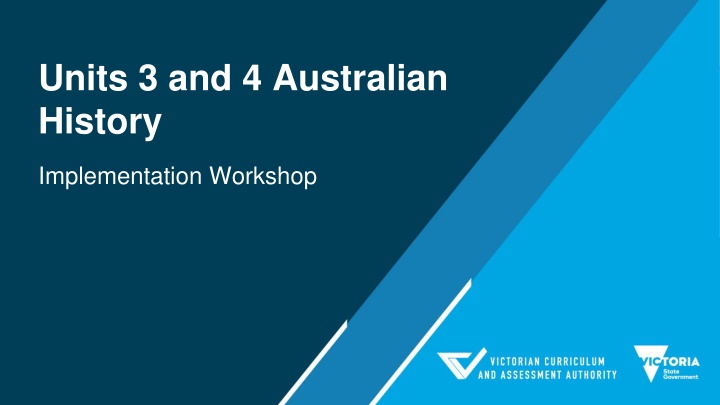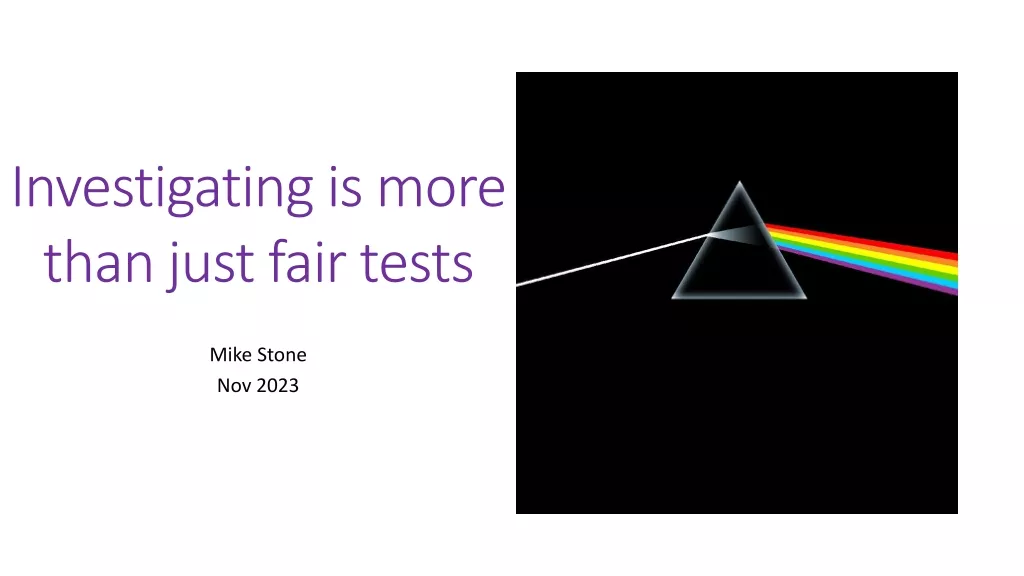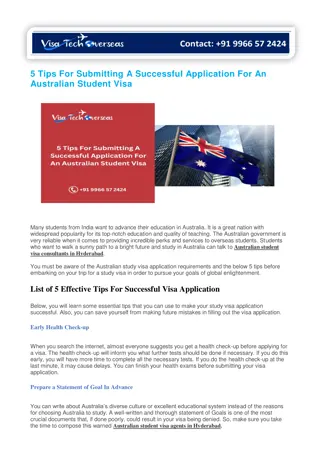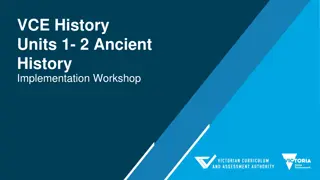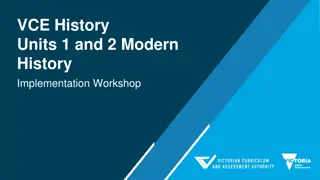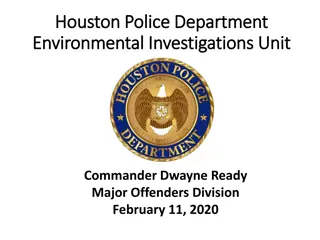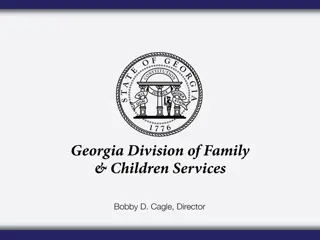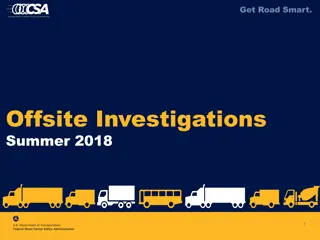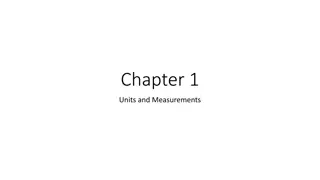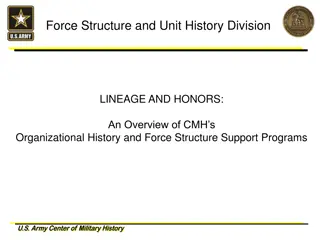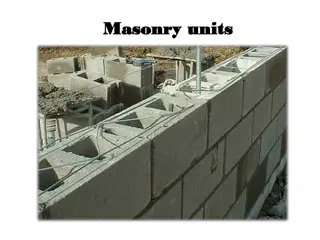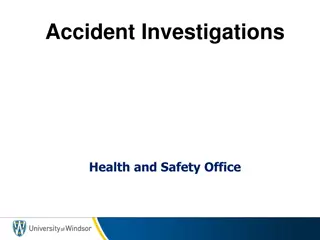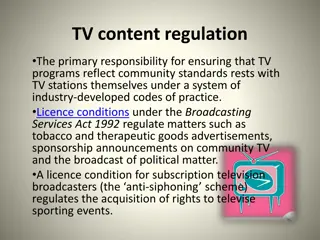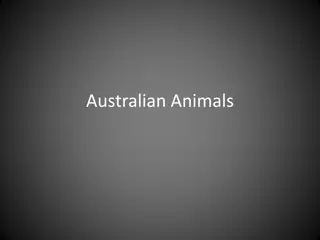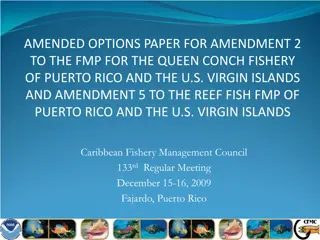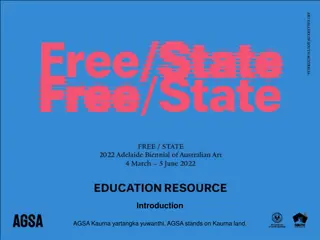Exploring Units 3 and 4 Australian History: Key Investigations and Big Planning Ideas
Delve into Units 3 and 4 Australian History focusing on key historical investigations such as custodianship to the Anthropocene, creating a nation, power and resistance, and war and upheaval. Discover new content, outcomes, and key knowledge while analyzing continuity and change in Australian society through significant events and experiences.
Download Presentation

Please find below an Image/Link to download the presentation.
The content on the website is provided AS IS for your information and personal use only. It may not be sold, licensed, or shared on other websites without obtaining consent from the author.If you encounter any issues during the download, it is possible that the publisher has removed the file from their server.
You are allowed to download the files provided on this website for personal or commercial use, subject to the condition that they are used lawfully. All files are the property of their respective owners.
The content on the website is provided AS IS for your information and personal use only. It may not be sold, licensed, or shared on other websites without obtaining consent from the author.
E N D
Presentation Transcript
Units 3 and 4 Australian History Implementation Workshop
Outline At a glance Features of Units 3 and 4 Australian History Overview of the areas of study Teaching ideas Questions
At a glance Units 3 and 4 Australian History Creating a nation From Power and resistance War and upheaval custodianship to the Anthropocene Foundations Transformations Area of Study 1 Area of Study 2
Features New content New historical investigations New Outcomes New key knowledge and key skills
Features Select 2 historical investigations from the following list: From custodianship to the Anthropocene (60,000 BCE 2010) Creating a nation (1834 2008) Power and resistance (1788 1998) War and upheaval (1909 1992). Select one for Unit 3 and one for Unit 4. The historical investigation selected in Unit 3, Area of Study 1, must be selected for Unit 3, Area of Study 2. The historical investigation selected in Unit 4, Area of Study 1, must be selected for Unit 4, Area of Study 2. It is the Key Knowledge within the timeframes that must be taught.
Big Planning Ideas What are your areas of expertise? Resources to draw upon? Faculty expertise? What grabs you/interests you? What do you think students will be interested in? Read through the key knowledge of the investigations and think of the big picture of continuity and change. Consider the chronology that runs through the key knowledge for each area of study. What is your starting point? What is your end point?
Units 3 and 4 Australian History Area of Study One Foundations in Australian History Outcome 1 Analyse the foundations of continuity and change in Australia, and evaluate the contribution of significant events, ideas, perspectives and experiences to continuity and change. Inquiry Questions What were the foundations of continuity and change in Australia? How did significant individuals and movements demand and/or resist change? How were Australians challenged over time by ideas and events? To what extent were there continuities and changes in Australian society? How did Australians influence and experience continuity and change?
Area of Study 1 Historical Investigations Timeframes From custodianship to the Anthropocene (60,000 BCE 1901) Creating a nation (1834 1913) Power and resistance (1788 1913) War and upheaval (1909 1950)
Structure and Planning The historical investigation selected for Area of Study 1 in Unit 3 and in Unit 4 must be the same historical investigation that was chosen for Area of Study 2 in Unit 3 and Unit 4.
Units 3 and 4 Australian History Foundations in Australian History the significant events that contributed to change the ideas that influenced attitudes towards and perspectives the diverse and competing perspectives on the extent to which changed and/or remained the same Area of Study One Key knowledge
Units 3 and 4 Australian History Foundations in Australian History Area of Study One Relationship between Key knowledge and Skills ask and use a range of historical questions to explore the foundations for continuity and change evaluate sources for use as evidence analyse the perspectives of people and how perspectives changed and/or remained the same over time evaluate historical interpretations about the foundations of continuity and change analyse the causes and consequences of continuity and change evaluate the extent of continuity and change in Australian society evaluate the historical significance of ideas and events that led to changes to, and continuities in, Australian society construct arguments about continuity and change in Australian history using sources as evidence.
Teaching and Learning Ideas War and Upheaval AOS1 provide students with primary sources relating to Australia s relationship with Britain from the period 1909-1950 Have students individually analyse one document to evaluate what this reveals about Australia s loyalty to the British Empire Students report their finding to the class; collaboratively create a graphic organiser or class display to chart Australian attitudes and perspectives towards the British Empire over time
Creating a Nation AOS1 Teaching and Learning Ideas C/L Decision Summary: Note the date of the decision and its main purpose Continuities: Note ways in which the decision continued or affirmed colonial policies in these areas Changes Note specific consequences of the decision, including impacts on other government policies Section 51, xxvi of the Constitution, Immigration Restriction Act, 1901 Students should then use the table to evaluate the extent of change these decisions represented. Pacific Island Labourers Act, 1901
Teaching and Learning Ideas Power and Resistance AOS1 Fishbone Diagrams Can be used to help organise cause and effect Women s equality Liberalism Chartism Development of Australian democracy to 1913 New Unionism Free trade & protectionism
Units 3 and 4 Australian History Area of Study Two Transformations Outcome 2 Analyse the changes in Australian society, and evaluate the extent to which continuity and change occurred. Inquiry Questions What were the motivations for seeking continuity and change in modern Australia? How did significant individuals and movements demand and/or resist change? How were Australians challenged over time by events and ideas? To what extent were there continuities and changes in Australian society? How did Australians influence and experience continuity and change?
Area of Study 2 Historical Investigations Timeframes From custodianship to the Anthropocene (1950 2010) Creating a nation (1945 2008) Power and resistance (1957 1998) War and upheaval (1950 1992).
Structure and Planning The historical investigation selected for Area of Study 2 in Unit 3 and in Unit 4 must be the same historical investigation that was chosen for Area of Study 1 in Unit 3 and Unit 4
Units 3 and 4 Australian History Area of Study Two Transformations Key knowledge the significant events that contributed to ideas that influenced the diverse and competing perspectives the extent to which changed and/or remained the same the extent of continuity and change
Units 3 and 4 Outcome 2: final dot point the extent of continuity and change in perspectives towards environmental issues and awareness in Australia 60,000 BCE 2010. the extent of continuity and change regarding reasons for and debates about race, immigration and citizenship in Australia 1834 2008. the extent of continuity and change in the exercise of power and resistance in Australia 1788 1998. the extent of continuity and change in Australia s experiences of war and conflict 1909 1992.
Units 3 and 4 Outcome 2 the extent of continuity and change in Think holistically about the extent of change Examine continuity and change across the whole investigation Allows students to use knowledge across the narrative to illustrate continuity and change Students will be able to use knowledge from Outcome 1 to explain the extent of change in relation to knowledge in Outcome 2
Area of Study Two Relationship between Key knowledge and Skills Transformations ask and use a range of historical questions to explore continuity and change evaluate sources for use as evidence analyse the perspectives of people and how perspectives changed and/or remained the same over time evaluate historical interpretations about continuity and change analyse the causes and consequences of continuity and change evaluate the extent of continuity and change in Australian society evaluate the historical significance of changes to and continuities in Australian society construct arguments about continuity and change in Australian history using sources as evidence.
Teaching and Learning Ideas Custodianship to the Anthropocene AOS2 Significant environmental campaigns jigsaw A jigsaw learning activity emphasises peer teaching and collaborative learning. The object is for small groups of students to become experts on a topic, and then split up to teach that topic to their peers, and, in turn, to be instructed by them on the other topics selected to investigate.
Teaching and Learning Ideas Analysis of sources political cartoons Power and Resistance AOS2 Use a search engine such as Trove to find political cartoons on campaigns such as Aboriginal Land Rights Ask students to complete a table noting historical context, perspective and impact Historical context Historical details for event depicted Perspective What is the perspective of the cartoonist? What makes you say that? Impact Evaluate how likely this may have contributed to change?
Assessment Ideas Suitable tasks for assessment in these units may be selected from the following: a historical inquiry an essay evaluation of historical sources extended responses
Evaluation of historical sources: Example Power & Resistance AOS2 Outcome 2: Analyse the changes in Australian society, and evaluate the extent to which continuity and change occurred. Use 3-4 sources, mix of primary and historian sources Seek to asses a wider range of key knowledge Source 1: Zelda D Aprano s reflection on protesting for equal pay Source 2: Photograph of the Aboriginal Tent Embassy with different signs Source 3: Extract from historian Michelle Arrow on the impact of Germaine Greer and Dennis Altmann
Evaluation of historical sources Develop 4-6 questions on the sources Different levels of cognitive development accessible to a range of learners Q1: Identify from Source 1 D Aprano scritique of the Arbitration Commission s hearing (2 marks) Q2: Outline from Source 2 The demands of the Tent Embassy protest (4 marks) Q3: Describe the rise of women s and gay liberation movements in the early 1970s, using S3 and your own knowledge. (5 marks) Q4: Explain the resistance to demands for change up until 1972. Use the sources and your own knowledge. (6 marks) Q5: Evaluate the extent to which the election of the Whitlam government in 1972 resulted in lasting change for women s rights. Use Sources 1 and 3 and your own knowledge. (8 marks) Q6: To what extent did the black power movement influence demands for land rights by Aboriginal and Torres Strait Islander peoples in the 1970s? Use S2 and your own knowledge. (10 marks)
Example: Historical inquiry The updated 2022 Advice for Teachers has detailed advice on developing a historical inquiry. Key components: Planning / Investigating / Writing up Considerations: Alignment with key knowledge and skills Time frame Authentication
Example: Historical Inquiry Custodianship to the Anthropocene AOS1 Research question: How did the changes in land use caused by colonisation impact both settlers and Aboriginal and Torres Strait Islander peoples? Process: Guide students to compile a portfolio of sources and notes. Encourage students to find and use primary sources (SLV & Trove great resources), and historian interpretation. Portfolio can be collected at the end of lessons. Scaffold the research process provide links, access to books and copies of sources. Limit the time. Response to structured questions in class, under timed conditions using the portfolio. Essay / analytic report / Extended response questions
Historical inquiry: further possible questions Power and Resistance AOS1: What were the diverse and competing perspectives on the issue of votes for women? Creating a Nation AOS1: How did colonial legislation in the 19th century shape ideas of a white Australia at federation? War and Upheaval AOS2: How has the commemoration of war influenced ideas about service in war between 1909 and 1992?
TEACHING IDEAS HISTORICAL INVESTIGATIONS
From custodianship to the Anthropocene (60,000 BCE 2010) Outcome 1 Big ideas: Impact of colonisation on the land and people Aboriginal land management Environmental outcomes of colonisation Outcome 2 Big ideas: Changing views of the environment after WW2 Role of Indigenous peoples in advocating for the environment. The extent to which environment movements affected change.
From custodianship to the Anthropocene (60,000 BCE 2010) Across the two outcomes: Changes and continuities in views of land and the environment for both the settler-colonial society and Aboriginal and Torres Strait Islander peoples
Creating a nation (18342008) Outcome 1 Big ideas: The ways in which global movements of people impacted the Australian continent in the 19th C. Debates about who had a claim of belonging in the new society The creation of a nation that used ideas of race to determine citizenship Outcome 2 Big ideas: Changes brought about by migration after WW2 Challenges to ideas about belonging and citizenship The extent to which changes in attitudes about who was Australian
Creating a nation (1834 2008) Across the two outcomes: Changes and continuities in belonging and citizenship in Australia
Power and resistance (17881998) Outcome 1 Big ideas: The ways in which British power was resisted in frontier wars Debates about power and authority within colonial society Continued challenges to colonial power by Aboriginal peoples Outcome 2 Big ideas: The ways in which concepts of rights engaged groups to challenge political and social power structures. The ways in which change occurred in land rights, women s liberation and LGBTIQA+ rights The extent to which lasting change occurred
Power and resistance (1788 1998) Across the two outcomes: Changes and continuities in the exercise of power and resistance to it.
War and upheaval (19091992). Outcome 1 Big ideas: How did Australia s participation in war shape the nation? Who could serve and who was excluded from service? The changing responses to war and service in Australian society Outcome 2 Big ideas: The forces that shaped Australia s views on defence after WW2 Debates about service and participation in conflict The extent to which this had changed by 1992
War and Upheaval (1909-1992) Across the two outcomes: Changes and continuities in attitudes towards military service and the nation at war.
